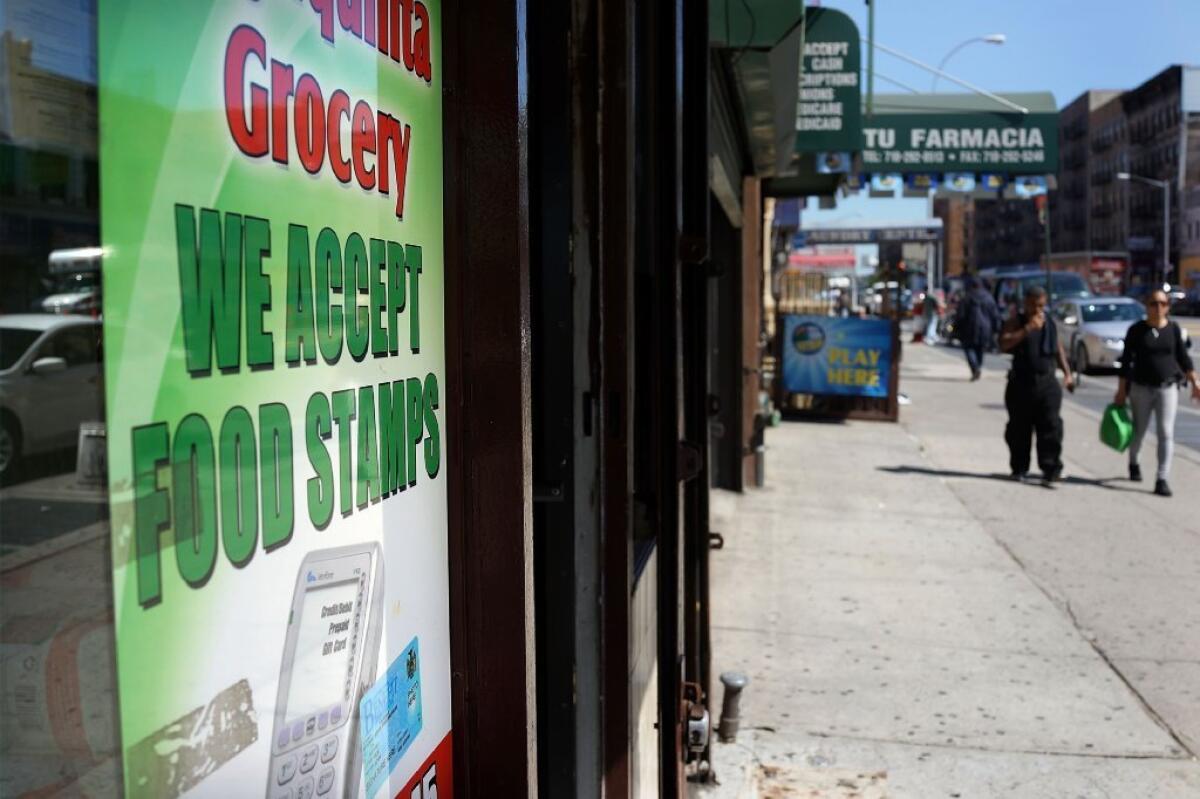Can food stamps help improve diets, fight obesity and save money?

Prohibiting the use of federal food stamps to purchase sugar-sweetened beverages and subsidizing the purchase of fruits and vegetables with the coupons would improve nutrition, foster weight loss and drive down rates of Type 2 diabetes among the program’s 47.6 million recipients, according to a new study.
In so doing, the $79.8-billion Supplemental Nutrition Assistance Program (SNAP) might also reap taxpayers untold future savings for the federally funded care of diabetes and other obesity-related ills among Medicaid recipients.
The benefits of making such changes to the program -- more commonly known as food stamps -- would be small and might take a decade to see. But while food stamp recipients often respond to rule changes by paying for disallowed items from their own pockets, such directives can, on balance, nudge their purchasing and consumption habits in positive directions, says a group of medical and health economics researchers from Stanford University and UC San Francisco.
The study was published this week in the journal Health Affairs. It was funded by the Robert Wood Johnson Foundation’s Healthy Eating Research Program.
The group tapped into existing databases to create a model of food purchasing, food consumption and purchasing choices and trade-offs by SNAP recipients.
They then looked at how those factors would change under two conditions: a rule that would prohibit the use of food stamps to buy sugar-sweetened beverages and a program that would remit 30% of the cost of fresh fruits and vegetables back into recipients’ accounts -- essentially subsidizing their produce purchases.
After calculating the dietary changes that would result from recipients’ changed buying patterns, the study authors modeled their impact on the health of the SNAP program’s low-income population, which is somewhat more obese than the general population and carries a far higher burden of Type 2 diabetes.
On a daily basis, the average SNAP recipient takes in 157 calories from sugar-sweetened beverages, versus 140 calories for a matched comparison group of non-SNAP recipients. A ban on the purchase of sweetened drinks with food stamps would prompt SNAP recipients to increase their purchase and consumption of fruit juices, the authors calculated.
But they reckoned that the average net caloric intake would decline by 11.4 calories per day. And a prohibition on the purchase of sugary drinks with food stamps would drive down the average recipient’s glycemic load -- a measure of blood sugar response to diet -- by 2.7 grams per day.
Over 10 years, the average food stamp recipient’s weight would decline by 1.15 pounds as a result. Some 422,000 people would not become obese -- the equivalent of a 2.4% decline from current obesity prevalence rates among SNAP participants.
And over a decade, 240,000 SNAP recipients would not be diagnosed with Type 2 diabetes, a 1.7% decline in the incidence of the metabolic disorder, which increases by two to four times the risk of stroke and heart attack.
Subsidizing the purchase of fruits and vegetable with food stamps resulted in health gains that were somewhat harder to measure. It certainly increased the purchase and consumption of fruits and vegetables among a population even less likely than the general popution to take in the recommended five portions a day.
Although the program puts food on many American tables, the health and nutrition status of food stamp recipients is poorer than average. The policy change would increase the fruit and vegetable intake of the average recipient by about a quarter-cup per day. That change would, in turn, boost the proportion of recipients meeting federal recommendations for daily fruit and vegetable consumption from a dismal 1.3% to a slightly less dismal 3.4%.
The fruit and vegetable subsidy would not change the average number of calories consumed by the average food stamp recipient, nor change the average glycemic load. Consequently, the policy had no noticeable effect on the incidence of obesity or Type 2 diabetes among recipients.
Still, the fruit and vegetable subsidy appears to be an easier policy prescription to sell, perhaps because it would not challenge the powerful beverage industry and because it would induce behavior change by enhancing access to nutritious foods rather than restricting access to those with no nutritional value.
The U.S. Department of Agriculture has run pilot programs, including one in Massachusetts, that subsidize fruits and vegetables and found benefits similar to those found here.
“The logic behind SNAP policy changes is that taxpayers are potentially subsidizing unhealthy food consumption and paying for its downstream health consequence,” the authors of the new study wrote.







